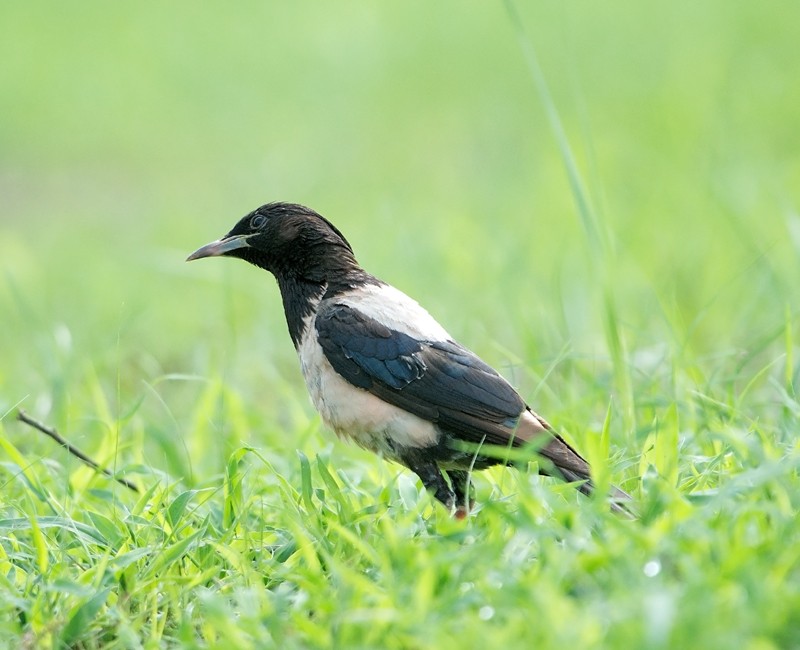Rosy Starling
A species of Starling, Also known as Rose-colored Starling Scientific name : Pastor roseus Genus : Starling
Rosy Starling, A species of Starling
Also known as:
Rose-colored Starling
Botanical name: Pastor roseus
Genus: Starling
Content
Description People often ask General Info
Description
The adult rosy starling is highly distinctive, with its pink body, pale orange legs and bill, and glossy black head, wings and tail. Males in the breeding season have elongated head feathers which form a wispy crest that is fluffed and more prominent when the bird gets excited. In winter, the crest is shorter, and the edges of black feathers within the plumage become paler as the edges of these feather erode. Winter plumage in males is comparatively dull. Females in contrast have a short crest and lack the sharp separation between pink and black. The juvenile birds can be distinguished from common starling (Sturnus vulgaris) by its obviously paler plumage and short yellow bill. Young birds moult into a subdued version of the adult plumage in autumn, yet these lack the crest. They do not acquire their adult plumage until they are nearly one year old in females, and nearly two years in males. The latter grow plumage very similar to adult females in their second year, but are distinguished by longer crests and noticeably pale feather edges than female juvenile birds. 
Size
21 cm
Colors
Black
Orange
Pink
Life Expectancy
11 years
Nest Placement
Cavity
Feeding Habits
Rosy Starling primarily consumes fruits, berries, nectar, grains, and insects. Their varied diet includes figs, grapes, insects like locusts and beetles, and grains such as jowar and bajra. Rosy Starling has adapted to exploit different food resources throughout its range.
Habitat
The rosy Starling primarily resides in steppe regions and open agricultural areas, with a preference for locations that have pronounced seasonal changes. These birds breed in the semi-deserts and steppes of Central and Southeastern Asia, often establishing colonies near water sources. While insects constitute a major part of their diet, they adapt to various habitats, including urban areas and wooded regions in tropical Asia, where they roost communally during winter.
Dite type
Granivorous
People often ask
General Info
Feeding Habits
Bird food type
Behavior
Rosy starlings are highly gregarious birds, and often form large, noisy flocks, which can on occasion be a pest for growers of cereal crops or orchards; the birds are strongly attracted to flowering trees. However, they are also greatly beneficial to farmers as they prey on pests such as locusts and grasshoppers, thereby limiting their numbers. The birds breed in tight colonies in a very short breeding season timed to take advantage of peak abundance of grasshoppers during May to June. 
Distribution Area
The breeding range of this bird is in steppes, semi-deserts and deserts of Central Asia and Southeast Europe. It can be found from northwestern Mongolia via Dzungarei, Xinjiang, Kazakhstan, Kyrgyzstan, Tajikistan, Uzbekistan and Turkmenistan to southern Russia, Ukraine, Azerbaijan and Armenia . Its southern range extends to the north of Afghanistan and Iran . Irregular and rare broods are also observed outside of this area (Romania) It is a strong migrant, and winters in India and tropical Asia. In India in winter, it often appears to outnumber the local starlings and mynas. The rosy starling is a bird of steppe and open agricultural land. In years when grasshoppers and other insects are abundant, it will erupt well beyond its core range, with significant numbers reaching France, the United Kingdom and Ireland. The starling is a summer visitor for northwestern Afghanistan, passage migrants in the rest of the Afghanistan and a regular winter visitor in most of Pakistan and India. 
Species Status
Not globally threatened.
Scientific Classification
Phylum
Chordates Class
Birds Order
Perching birds Family
Starlings Genus
Starling Species
Rosy Starling 